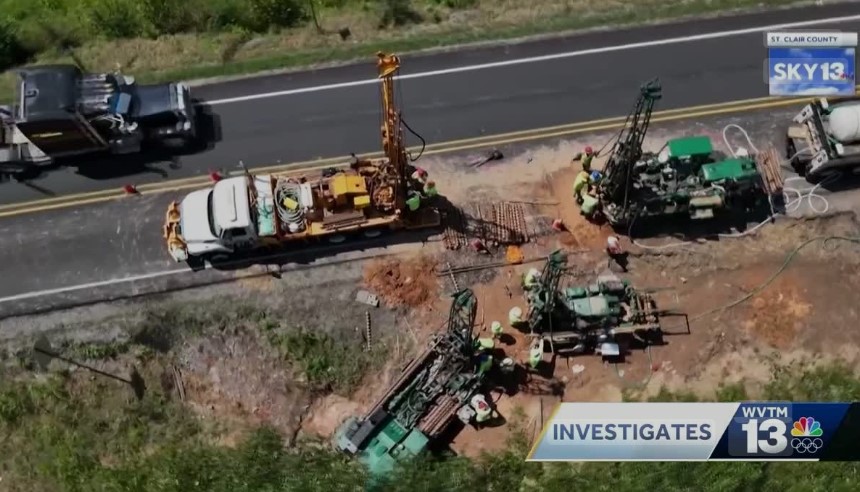‘Very concerning’: Persistent sinkhole on Highway 231 in St. Clair County leaves drivers on edge

By Scott Carpenter
Click here for updates on this story
ST. CLAIR COUNTY, Alabama (WVTM) — A large sinkhole along U.S. 231 near Pell City, Alabama, has opened multiple times since July, causing concern for drivers in St. Clair County as the Alabama Department of Transportation (ALDOT) works to find a permanent fix.
The sinkhole is dangerously close to the road, with patchwork visible in the northbound lane. ALDOT warns that the sinkhole could open again.
Laura Kohler, who drives past the sinkhole, said, “I don’t want to be around it.” She tries to avoid the area but must drive past it when heading to Pell City. Kohler added,”Part of the road is caved in.”
Jason Thrasher drives over the sinkhole for work. Both Kohler and Thrasher find the sight frightening. “Very concerning because you don’t know how big it’s gonna get the next time it opens up,” said Kohler.
Thrasher shared his experience, “I left one morning, they were working on it, fixed it. Then in two hours, I came across it and it had sunk some more.”
The sinkhole first opened in late July, reaching a depth of about 30 feet, and has reopened several times since. Video footage shows ALDOT crews filling the sinkhole with rocks and soil in August after it opened for the third time.
Scott Brande, a UAB associate chemistry professor with expertise in geology and sinkholes, explained the complexity of fixing a sinkhole. “You want to plug the hole at the bottom and so you want to put the larger size grains and gravel and stones at the bottom and gradually fill it with finer materials as you work toward the surface to fill all of the openings up,” Brande said.
He described the underground holes as complex and interconnected, similar to a sponge, and suggested they might be part of a complex cavern system.
Brande said, “My guess is in many areas the holes interconnect and they’re part of a maybe complex cavern system and whatever is poured into one opening may break through a narrow neck into another one.”
He noted that there are several reasons sinkholes can open up.
Residents in St. Clair County mentioned that construction work was being done on the road right before the sinkhole first appeared.
Kohler said, “They had resurfaced it recently, and right after it opened up.”
ALDOT refers to it as a “naturally occurring sinkhole” discovered during resurfacing work on U.S. 231.
Drivers are less concerned with how it opened. “Just fix it. That way we don’t have to deal with it,” said Thrasher.
ALDOT denied multiple requests for an interview, but sent the following statement.
“The naturally occurring sinkhole was originally discovered in late July while ALDOT crews were carrying out an unrelated resurfacing project on US-231. Sinkholes are relatively common in Alabama due to underground limestone deposits, which can dissolve over time, causing subterranean voids. Heavy rainfall recorded during the spring and early summer months may have contributed to the sinkhole’s original growth. Since our original emergency repair, ALDOT has performed additional work on the site’s foundation. That included sealing the bottom of the hole with concrete and compacting more dirt and rock with heavy equipment. We would not have reopened the road to traffic if we had any reservations about motorists’ safety. Over the last several weeks, ALDOT commissioned a thorough geotechnical analysis of the site to determine the best path forward. With that knowledge now in hand, ALDOT is monitoring the site on a daily basis and considering options for a more permanent repair if it becomes necessary to ensure the roadway’s stability and motorists’ safety.”
There are currently thousands of sinkholes across Alabama.
Please note: This content carries a strict local market embargo. If you share the same market as the contributor of this article, you may not use it on any platform.